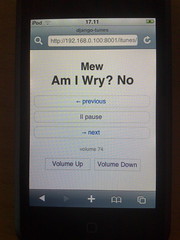 Back in 2008 I stumbled on then new API on Mac OS X called Scripting Bridge that enables easy controlling of Cocoa apps (like iTunes) from scripting languages like Python.
Back in 2008 I stumbled on then new API on Mac OS X called Scripting Bridge that enables easy controlling of Cocoa apps (like iTunes) from scripting languages like Python.
I wrote simple proof-of-concept Django app that turned my iPod touch into a remote control. It was cool, even though it didn’t do very much. Now there’s of course native iOS apps for this but I was somewhat surprised that there are still not much code for controlling iTunes via Web. I misplaced my original code so I decided to write it again — just for fun.
So here’s a working class for controlling iTunes, in 58 lines of Python:
# -*- coding: utf-8 -*- from Foundation import * from ScriptingBridge import * class iTunes(object): """ A helper class for interacting with iTunes on Mac OS X via Scripting Bridge framework. To use this, launch iTunes and make sure a playlist or an album is ready. Usage: >>> player = iTunes() >>> player.status 'playing' >>> player.current_track u'Maison Rilax' >>> player.current_album u'Maison Rilax' >>> player.current_artist u'Lemonator' >>> player.pause() >>> player.status 'paused' >>> player.play() >>> player.next() >>> player.current_track u'Not Your Game' """ def __init__(self): self.app = SBApplication.applicationWithBundleIdentifier_("com.apple.iTunes") def _get_status(self): if self.app.playerState() == 1800426320: return "playing" elif self.app.playerState() == 1800426352: return "paused" else: return "unknown" status = property(_get_status) def _get_current_track(self): return self.app.currentTrack().name() current_track = property(_get_current_track) def _get_current_artist(self): return self.app.currentTrack().artist() current_artist = property(_get_current_artist) def _get_current_album(self): return self.app.currentTrack().album() current_album = property(_get_current_album) def _set_volume(self, level): """ level should be an integer between 0-100. """ self.app.setSoundVolume_(level) def _get_volume(self): return self.app.soundVolume() volume = property(_get_volume, _set_volume) def pause(self): self.app.pause() def play(self): # According to AppleScript documentatin there should be a .play() # method, but apparently there isn't. So we fake it :) if self.status == "paused": self.app.playpause() def next(self): self.app.nextTrack() def previous(self): self.app.previousTrack() This could be easily refined into something potentially interesting like a native REST API for iTunes. The downside, of course, is that it only works on a Mac. (The code is available also on BitBucket.)
A somewhat related is a project called Mopidy, which is a Python powered MPD music server for the awesome Spotify music service (that is suposed to finally be launching in US very soon, I hear.). I’m not at all familiar with MPD but I think it wouldn’t be very difficult to build a Django frontend to a server like Mopidy to get a very slick Web-based interface to your music. Now that would be cool.